MADS-Box Family Genes in Lagerstroemia indica and Their Involvement in Flower Development
Abstract
1. Introduction
2. Results
2.1. Identification of LiMADS Gene Family Members and Physicochemical Analysis
2.2. Phylogenetic Analysis of LiMADS Gene Family Members
2.3. Chromosome Distribution and Gene Collinearity Analysis of LiMADS in L. indica
2.4. Analysis of LiMADS Gene Structure and Conserved Motifs in L. indica
2.5. Prediction of Cis-Acting Elements in the LiMADS Gene Family of L. indica
2.6. Analysis of Protein-Protein Interaction Network of LiMADS Gene
2.7. Analysis of LiMADS Gene Expression Levels at Different Flower Development Stages
2.8. Changes in Hormone Levels during Organ Development of L. indica Flowers
3. Discussion
4. Materials and Methods
4.1. Identification of MADS Gene in the Genome of L. indica
4.2. Phylogenetic Analysis of LiMADS
4.3. Chromosome Location and Synteny Analysis of the MADS-Box Gene Family
4.4. LiMADS Gene Structure Analysis and Cloning
4.5. Prediction of Cis-Regulatory Elements in the Promoter Region
4.6. Analysis of LiMADS Protein-Protein Interaction Network
4.7. Expression Analysis of MADS Gene at Different Stages of L. indica Flower Development
4.8. Analysis of Hormone Levels at Different Stages of L. indica Flower Development
4.9. Data Processing
5. Conclusions
Supplementary Materials
Author Contributions
Funding
Data Availability Statement
Conflicts of Interest
References
- Wils, C.R.; Kaufmann, K. Gene-regulatory networks controlling inflorescence and flower development in Arabidopsis thaliana. Biochim. Biophys. Acta. Gene Regul. Mech. 2017, 1860, 95–105. [Google Scholar] [CrossRef] [PubMed]
- Coen, E.S.; Meyerowitz, E.M. The war of the whorls: Genetic interactions controlling flower development. Nature 1991, 353, 31–37. [Google Scholar] [CrossRef] [PubMed]
- Lu, H.; Liu, Z.; Lan, S. Genome sequencing reveals the role of mads-box gene families in the floral morphology evolution of orchids. Hortic. Plant J. 2019, 5, 8. [Google Scholar] [CrossRef]
- Kieffer, M.; Davies, B. Developmental programmes in floral organ formation. Semin. Cell Dev. Biol. 2001, 12, 373–380. [Google Scholar] [CrossRef]
- Chandler, J.W. Class VIIIb APETALA2 ethylene response factors in plant development. Trends Plant Sci. 2018, 23, 151–162. [Google Scholar] [CrossRef]
- Theissen, G.; Kim, J.T.; Saedler, H. Classification and phylogeny of the MADS-box multigene family suggest defined roles of MADS-box gene subfamilies in the morphological evolution of eukaryotes. J. Mol. Evol. 1996, 43, 484–516. [Google Scholar] [CrossRef]
- Liljegren, S.J.; Ditta, G.S.; Eshed, Y.; Savidge, B.; Bowman, J.L.; Yanofsky, M.F. SHATTERPROOF MADS-box genes control seed dispersal in Arabidopsis. Nature 2000, 404, 766–770. [Google Scholar] [CrossRef]
- Nam, J.; dePamphilis, C.W.; Ma, H.; Nei, M. Antiquity and evolution of the MADS-box gene family controlling flower development in plants. Mol. Biol. Evol. 2003, 20, 1435–1447. [Google Scholar] [CrossRef]
- Qiu, Y.C.; Köhler, C. Endosperm evolution by duplicated and neofunctionalized type I MADS-Box transcription factors. Mol. Biol. Evol. 2022, 39, msab355. [Google Scholar] [CrossRef]
- Lai, X.L.; Daher, H.; Galien, A.; Hugouvieux, V.; Zubieta, C. Structural basis for plant MADS transcription factor oligomerization. Comput. Struct. Biotechnol. J. 2019, 17, 946–953. [Google Scholar] [CrossRef]
- Gramzow, L.; Theissen, G. A hitchhiker’s guide to the MADS world of plants. Genome Biol. 2010, 11, 214. [Google Scholar] [CrossRef]
- Becker, A.; Theissen, G. The major clades of MADS-box genes and their role in the development and evolution of flowering plants. Mol. Phylogenet. Evol. 2003, 29, 464–489. [Google Scholar] [CrossRef] [PubMed]
- Liu, Y.; Cui, S.J.; Wu, F.; Yan, S.; Lin, X.L.; Du, X.Q.; Chong, K.; Schilling, S.; Theißen, G.; Meng, Z. Functional conservation of MIKC*-Type MADS box genes in Arabidopsis and rice pollen maturation. Plant Cell 2013, 25, 1288–1303. [Google Scholar] [CrossRef]
- Kwantes, M.; Liebsch, D.; Verelst, W. How MIKC* MADS-box genes originated and evidence for their conserved function throughout the evolution of vascular plant gametophytes. Mol. Biol. Evol. 2012, 29, 293–302. [Google Scholar] [CrossRef] [PubMed]
- Yamaguchi, N.; Huang, J.B.; Xu, Y.F.; Tanoi, K.; Ito, T. Fine-tuning of auxin homeostasis governs the transition from floral stem cell maintenance to gynoecium formation. Nat. Commun. 2017, 8, 1125. [Google Scholar] [CrossRef]
- Lymperopoulos, P.; Msanne, J.; Rabara, R. Phytochrome and Phytohormones: Working in tandem for plant growth and development. Front. Plant Sci. 2018, 9, 1037. [Google Scholar] [CrossRef] [PubMed]
- Wang, Z.J.; Ren, Z.Y.; Cheng, C.H.; Wang, T.; Ji, H.T.; Zhao, Y. Counteraction of ABA-mediated inhibition of seed germination and seedling establishment by ABA signaling terminator in Arabidopsis. Mol. Plant 2020, 13, 1284–1297. [Google Scholar] [CrossRef]
- Wu, W.Q.; Du, K.; Kang, X.Y.; Wei, H.R. The diverse roles of cytokinins in regulating leaf development. Hortic. Res. 2021, 8, 118. [Google Scholar] [CrossRef]
- Qiao, Z.Q.; Liu, S.S.; Zeng, H.J.; Li, Y.X.; Wang, X.M.; Chen, Y.; Wang, X.; Cai, N. Exploring the molecular mechanism underlying the stable purple-red leaf phenotype in Lagerstroemia indica cv. Ebony Embers. Int. J. Mol. Sci. 2019, 20, 5636. [Google Scholar] [CrossRef]
- Hu, L.; Zheng, T.; Cai, M.; Pan, H.; Zhang, Q. Transcriptome analysis during floral organ development provides insights into stamen petaloidy in Lagerstroemia speciosa. Plant Physiol. Biochem. 2019, 142, 510–518. [Google Scholar] [CrossRef]
- Wang, X.; Chen, J.; Zeng, H.J.; Qiao, Z.Q.; Li, Y.; Cai, N.; Wang, X. Lagerstroemia indica ‘Xiangyun’, a seedless crape myrtle. HortScience 2014, 49, 1590–1592. [Google Scholar] [CrossRef]
- Zhou, W.; Chen, J.H.; Wang, X.M.; Zeng, H.J.; Qiao, Z.Q. Germination characteristics of fruiting and nonfruiting Lagerstroemia indica pollen. J. Cent. South Univ. For. Technol. 2023, 43, 74–81. (In Chinese) [Google Scholar]
- Colombo, M.; Masiero, S.; Vanzulli, S.; Lardelli, P.; Kater, M.M.; Colombo, L. AGL23, a type I MADS-box gene that controls female gametophyte and embryo development in Arabidopsis. Plant J. 2008, 54, 1037–1048. [Google Scholar] [CrossRef] [PubMed]
- Steffen, J.G.; Kang, I.; Portereiko, M.F.; Lloyd, A.; Drews, G.N. AGL61 interacts with AGL80 and is required for central cell development in Arabidopsis. Plant Physiol. 2008, 148, 259–268. [Google Scholar] [CrossRef] [PubMed]
- Portereiko, M.F.; Lloyd, A.; Steffen, J.G.; Punwani, J.A.; Otsuga, D.; Drews, G.N. AGL80 is required for central cell and endosperm development in Arabidopsis. Plant Cell 2006, 18, 1862–1872. [Google Scholar] [CrossRef] [PubMed]
- Zhang, S.S.; Wang, D.F.; Zhang, H.J.; Skaggs, M.I.; Lloyd, A.; Ran, D.; An, L.; Schumaker, K.S.; Drews, G.N.; Yadegari, R. FERTILIZATION-INDEPENDENT SEED-polycomb repressive complex 2 plays a dual role in regulating type I MADS-box genes in early endosperm development. Plant Physiol. 2018, 177, 285–299. [Google Scholar] [CrossRef] [PubMed]
- Tapia-López, R.; García-Ponce, B.; Dubrovsky, J.G.; Garay-Arroyo, A.; Pérez-Ruíz, R.V.; Kim, S.H.; Acevedo, F.; Pelaz, S.; Alvarez-Buylla, E.R. An AGAMOUS-related MADS-box gene, XAL1 (AGL12), regulates root meristem cell proliferation and flowering transition in Arabidopsis. Plant Physiol. 2008, 146, 1182–1192. [Google Scholar] [CrossRef]
- Han, P.; García-Ponce, B.; Fonseca-Salazar, G.; Álvarez-Buylla, E.; Yu, H. Agamous-like 17, a novel flowering promoter, acts in a FT-independent photoperiod pathway. Plant J. 2008, 55, 253–265. [Google Scholar] [CrossRef]
- Rounsley, S.D.; Ditta, G.S.; Yanofsky, M.F. Diverse roles for MADS box genes in Arabidopsis development. Plant Cell 1995, 7, 1259–1269. [Google Scholar] [CrossRef]
- Joshi, S.; Paul, P.; Hartman, J.M.; Perry, S.E. AGL15 Promotion of somatic embryogenesis: Role and molecular mechanism. Front. Plant Sci. 2022, 13, 861556. [Google Scholar] [CrossRef]
- Dorca, F.C.; Gregis, V.; Grandi, V.; Coupland, G.; Colombo, L.; Kater, M.M. The Arabidopsis SOC1-like genes AGL42, AGL71 and AGL72 promote flowering in the shoot apical and axillary meristems. Plant J. 2011, 67, 1006–1017. [Google Scholar] [CrossRef] [PubMed]
- Zhang, Z.; Li, J.; Zhao, X.Q.; Wang, J.; Wong, G.K.; Yu, J. KaKs_Calculator: Calculating Ka and Ks through model selection and model averaging. Genom. Proteom. Bioinform. 2006, 4, 259–263. [Google Scholar] [CrossRef] [PubMed]
- Whittaker, C.; Dean, C. The FLC Locus: A Platform for Discoveries in Epigenetics and Adaptation. Annu. Rev. Cell Dev. Biol. 2017, 33, 555–575. [Google Scholar] [CrossRef] [PubMed]
- Hedden, P.; Phillips, A.L. Gibberellin metabolism: New insights revealed by the genes. Trends Plant Sci. 2000, 5, 523–530. [Google Scholar] [CrossRef] [PubMed]
- Stintzi, A.; Browse, J. The Arabidopsis male-sterile mutant, opr3, lacks the 12-oxophytodienoic acid reductase required for jasmonate synthesis. Proc. Natl. Acad. Sci. USA 2000, 97, 10625–10630. [Google Scholar] [CrossRef] [PubMed]
- Ng, M.; Yanofsky, M.F. Function and evolution of the plant MADS-box gene family. Nat. Rev. Genet. 2001, 2, 186–195. [Google Scholar] [CrossRef]
- Zhao, Y.; Zhao, H.; Wang, Y.; Zhang, X.; Zhao, X.; Yuan, Z. Genome-wide identification and expression analysis of MIKC-type MADS-Box gene family in Punica granatum L. Agronomy 2020, 10, 1197. [Google Scholar] [CrossRef]
- Zhou, P.Y.; Qu, Y.S.; Wang, Z.W.; Huang, B.; Wen, Q.; Xin, Y.; Xu, L. Gene structural specificity and expression of gene family in Camellia chekiangoleosa. Int. J. Mol. Sci. 2023, 24, 3434. [Google Scholar] [CrossRef]
- Hong, X.; Scofield, D.G.; Lynch, M. Intron size, abundance, and distribution within untranslated regions of genes. Mol. Biol. Evol. 2006, 23, 2392–2404. [Google Scholar] [CrossRef]
- Lin, C.S.; Hsu, C.T.; Liao, D.C.; Chang, W.J.; Chou, M.L.; Huang, Y.T.; Chen, J.J.W.; Ko, S.; Chan, M.; Shih, M. Transcriptome-wide analysis of the MADS-box gene family in the orchid Erycina pusilla. Plant Biotechnol. J. 2016, 14, 284–298. [Google Scholar] [CrossRef]
- José, D.; Diego, L.; José, M.M.; José, C.M. Genome-wide analysis of MIKCc-type MADS box genes in grapevine. Plant Physiol. 2009, 149, 354–369. [Google Scholar] [CrossRef]
- Li, H.X.; Li, Y.X.; Zhang, X.X.; Cai, K.W.; Li, Y.; Wang, Q.C.; Qu, G.; Han, R.; Zhao, X. Genome-wide identification and expression analysis of the MADS-box gene family during female and male flower development in Juglans mandshurica. Front. Plant Sci. 2022, 13, 1020706. [Google Scholar] [CrossRef] [PubMed]
- Zhao, D.; Chen, Z.; Xu, L.; Zhang, L.; Zou, Q. Genome-wide analysis of the MADS-Box gene family in maize: Gene structure, evolution, and relationships. Genes 2021, 12, 1956. [Google Scholar] [CrossRef]
- Ning, K.; Han, Y.Y.; Chen, Z.J.; Luo, C.; Wang, S.L.; Zhang, W.J.; Li, L.; Zhang, X.; Fan, S.; Wang, Q. Genome-wide analysis of MADS-box family genes during flower development in lettuce. Plant Cell Environ. 2019, 42, 1868–1881. [Google Scholar] [CrossRef] [PubMed]
- Wuest, S.E.; O’Maoileidigh, D.S.; Rae, L.; Kwasniewska, K.; Raganelli, A.; Hanczaryk, K.; Lohan, A.J.; Loftus, B.; Graciet, E.; Wellmer, F. Molecular basis for the specification of floral organs by APETALA3 and PISTILLATA. Proc. Natl. Acad. Sci. USA 2012, 109, 13452–13457. [Google Scholar] [CrossRef]
- Kong, H.Z.; Landherr, L.L.; Frohlich, M.W.; Leebens-Mack, J.; Ma, H.; dePamphilis, C.W. Patterns of gene duplication in the plant SKP1 gene family in angiosperms: Evidence for multiple mechanisms of rapid gene birth. Plant J. 2007, 50, 873–885. [Google Scholar] [CrossRef] [PubMed]
- Airoldi, C.A.; Davies, B. Gene duplication and the evolution of plant MADS-box transcription factors. J. Genet. Genom. 2012, 39, 157–165. [Google Scholar] [CrossRef]
- Gregis, V.; Sessa, A.; Dorca-Fornell, C.; Kater, M.M. The Arabidopsis floral meristem identity genes AP1, AGL24 and SVP directly repress class B and C floral homeotic genes. Plant J. 2009, 60, 626–637. [Google Scholar] [CrossRef]
- Brownfield, L. Plant breeding: Revealing the secrets of cytoplasmic male sterility in wheat. Curr. Biol. 2021, 31, R724–R726. [Google Scholar] [CrossRef]
- Cheng, Z.H.; Song, W.Y.; Zhang, X.L. Genic male and female sterility in vegetable crops. Hortic. Res. 2023, 10, uhac232. [Google Scholar] [CrossRef]
- Farinati, S.; Draga, S.; Betto, A.; Palumbo, F.; Vannozzi, A.; Lucchin, M.; Barcaccia, G. Current insights and advances into plant male sterility: New precision breeding technology based on genome editing applications. Front. Plant Sci. 2023, 14, 1223861. [Google Scholar] [CrossRef] [PubMed]
- García-Sogo, B.; Pineda, B.; Castelblanque, L.; Antón, T.; Medina, M.; Roque, E.; Torresi, C.; Beltrán, J.P.; Moreno, V.; Cañas, L.A. Efficient transformation of Kalanchoe blossfeldiana and production of male-sterile plants by engineered anther ablation. Plant Cell Rep. 2010, 29, 61–77. [Google Scholar] [CrossRef]
- Reeves, P.H.; Ellis, C.M.; Ploense, S.E.; Wu, M.F.; Yadav, V.; Tholl, D.; Chételat, A.; Haupt, I.; Kennerley, B.J.; Hodgens, C.; et al. A regulatory network for coordinated flower maturation. PLoS Genet. 2012, 8, e1002506. [Google Scholar] [CrossRef] [PubMed]
- Khan, A.H.; Ma, Y.; Wu, Y.; Akbar, A.; Shaban, M.; Ullah, A.; Deng, J.; Khan, A.S.; Chi, H.; Zhu, L.; et al. High-temperature stress suppresses allene oxide cyclase 2 and causes male sterility in cotton by disrupting jasmonic acid signaling. Crop J. 2023, 11, 33–45. [Google Scholar] [CrossRef]
- He, Y.; Liu, C.; Zhu, L.; Fu, M.; Sun, Y.; Zeng, H. Jasmonic acid plays a pivotal role in pollen development and fertility regulation in different types of P(T)GMS rice lines. Int. J. Mol. Sci. 2021, 22, 7926. [Google Scholar] [CrossRef] [PubMed]
- Schubert, R.; Dobritzsch, S.; Gruber, C.; Hause, G.; Athmer, B.; Schreiber, T.; Marillonnet, S.; Okabe, Y.; Ezura, H.; Acosta, I.F.; et al. Tomato MYB21 Acts in Ovules to Mediate Jasmonate-Regulated Fertility. Plant Cell 2019, 31, 1043–1062. [Google Scholar] [CrossRef]
- Jang, G.; Yoon, Y.; Choi, Y.D. Crosstalk with jasmonic acid integrates multiple responses in plant development. Int. J. Mol. Sci. 2020, 21, 305. [Google Scholar] [CrossRef]
- Chen, C.J.; Chen, H.; Zhang, Y.; Thomas, H.R.; Frank, M.H.; He, Y.H.; Xia, R. TBtools: An integrative toolkit developed for interactive analyses of big biological data. Mol. Plant 2020, 13, 1194–1202. [Google Scholar] [CrossRef]
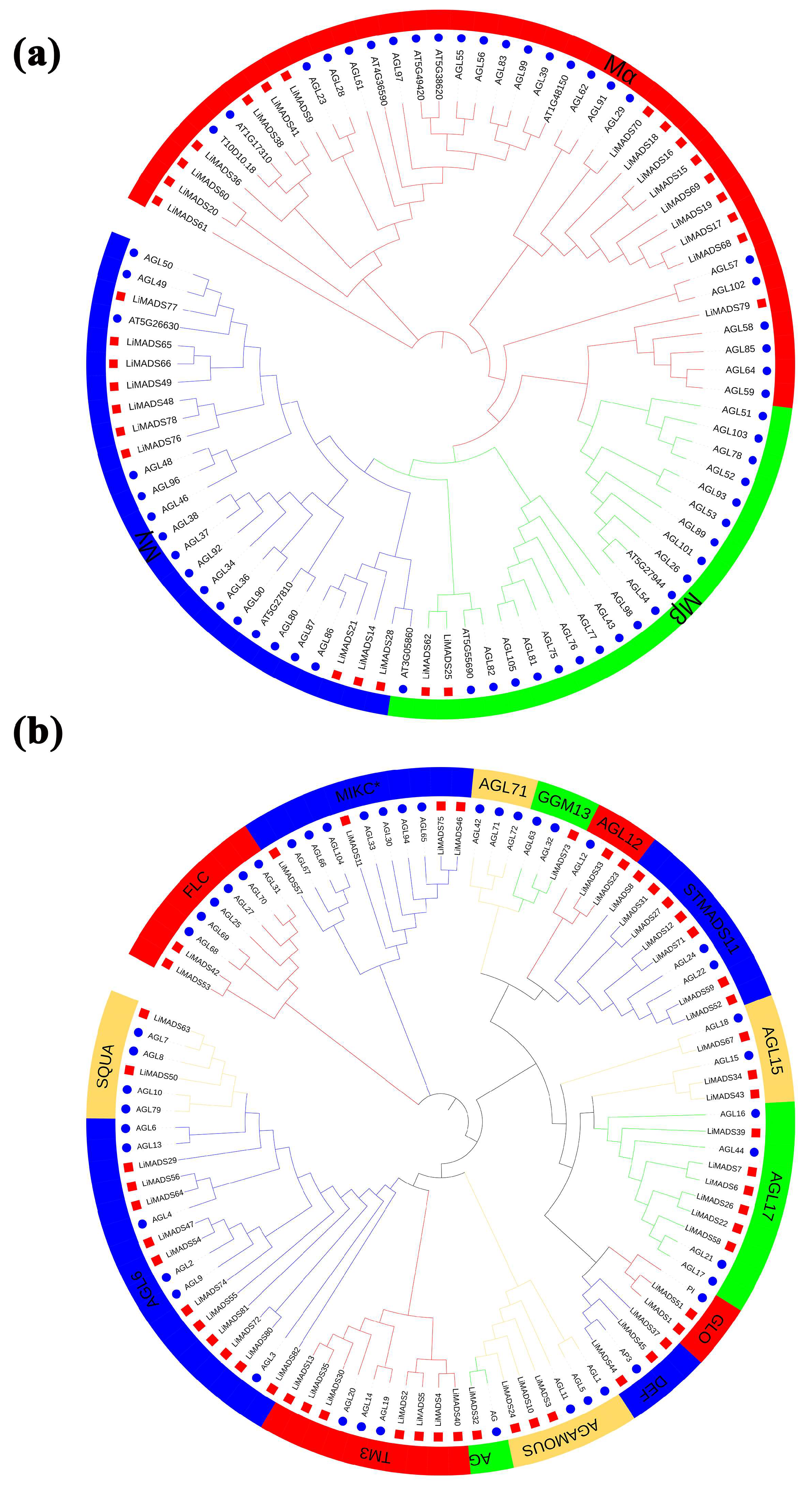
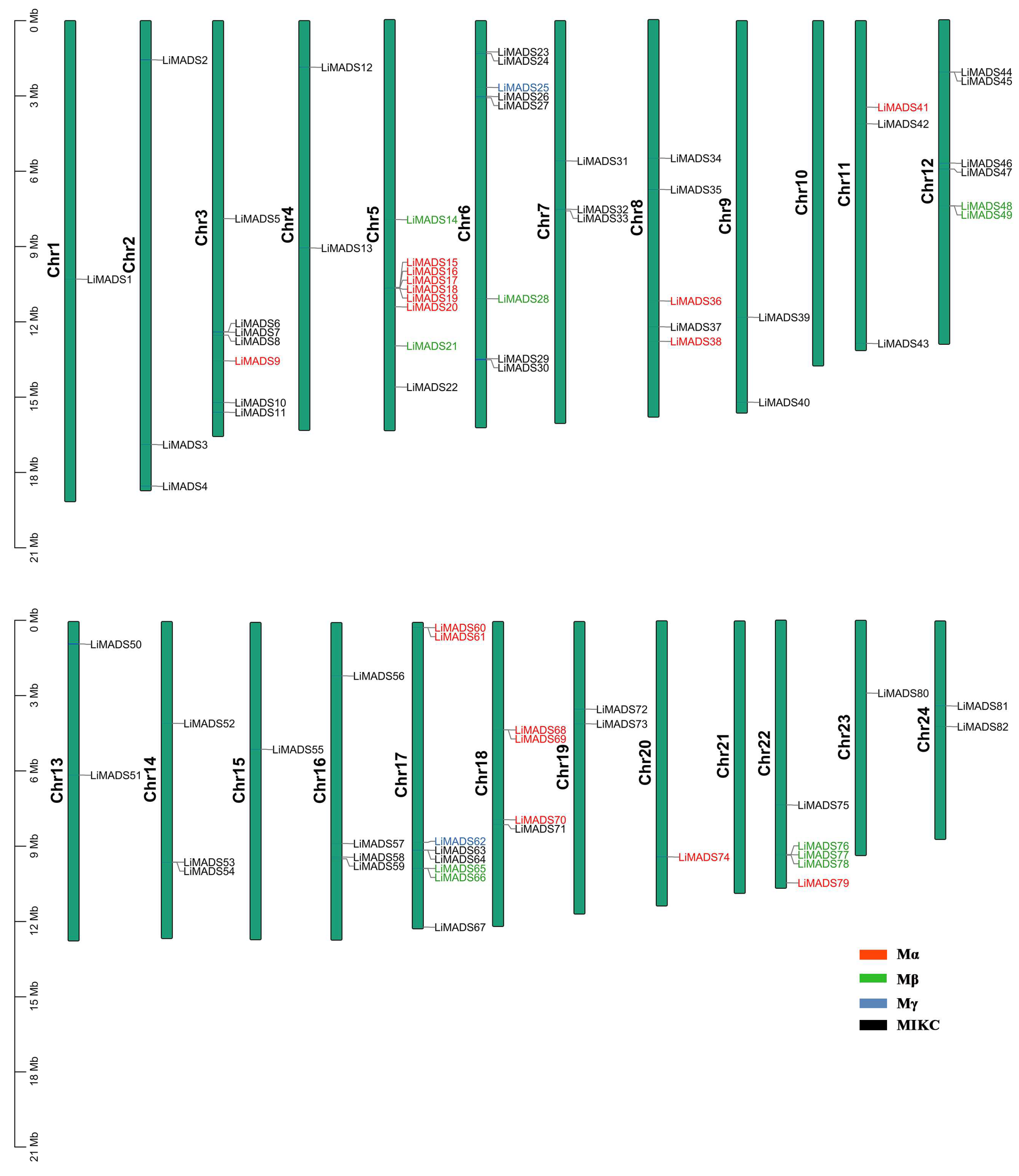
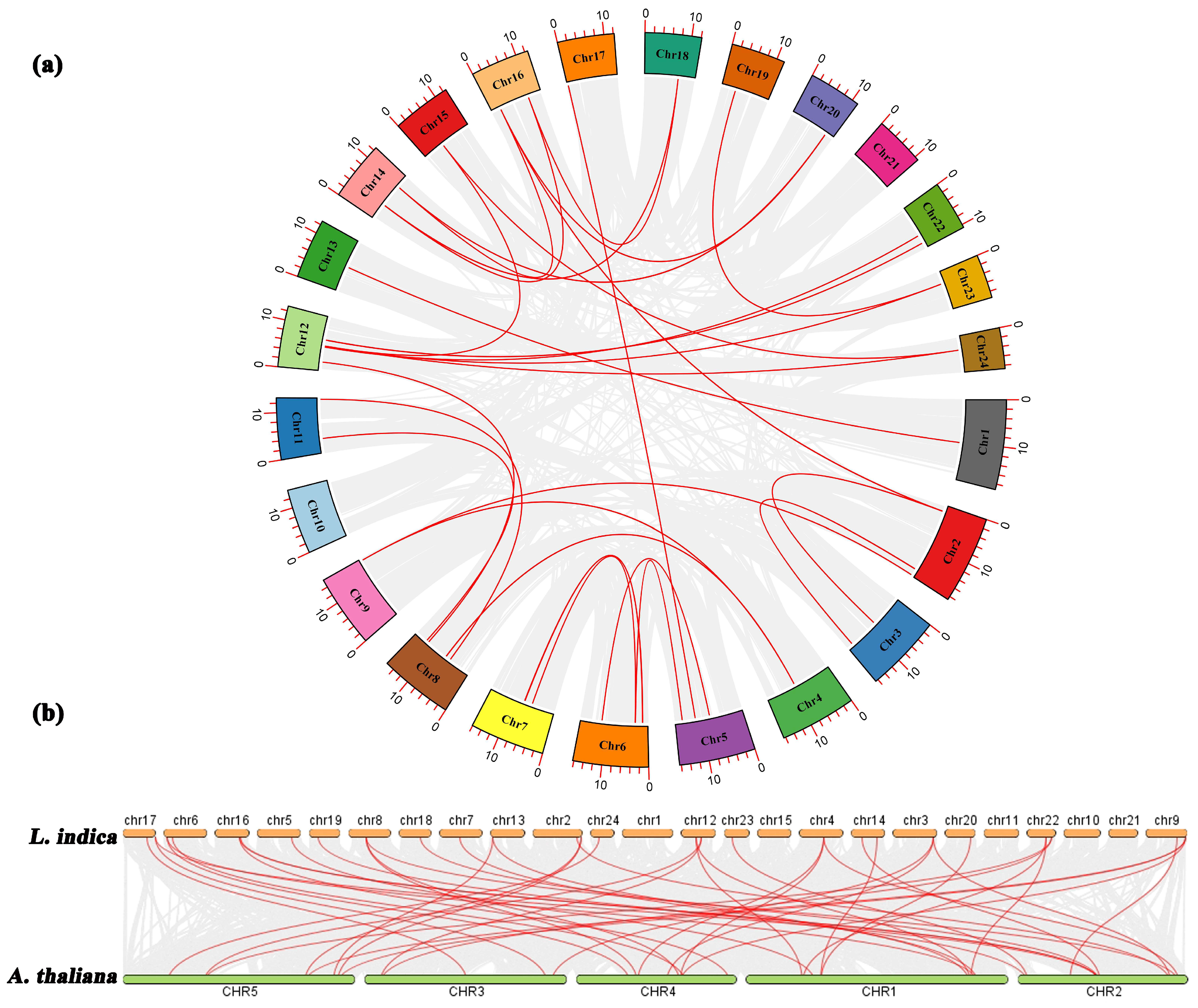
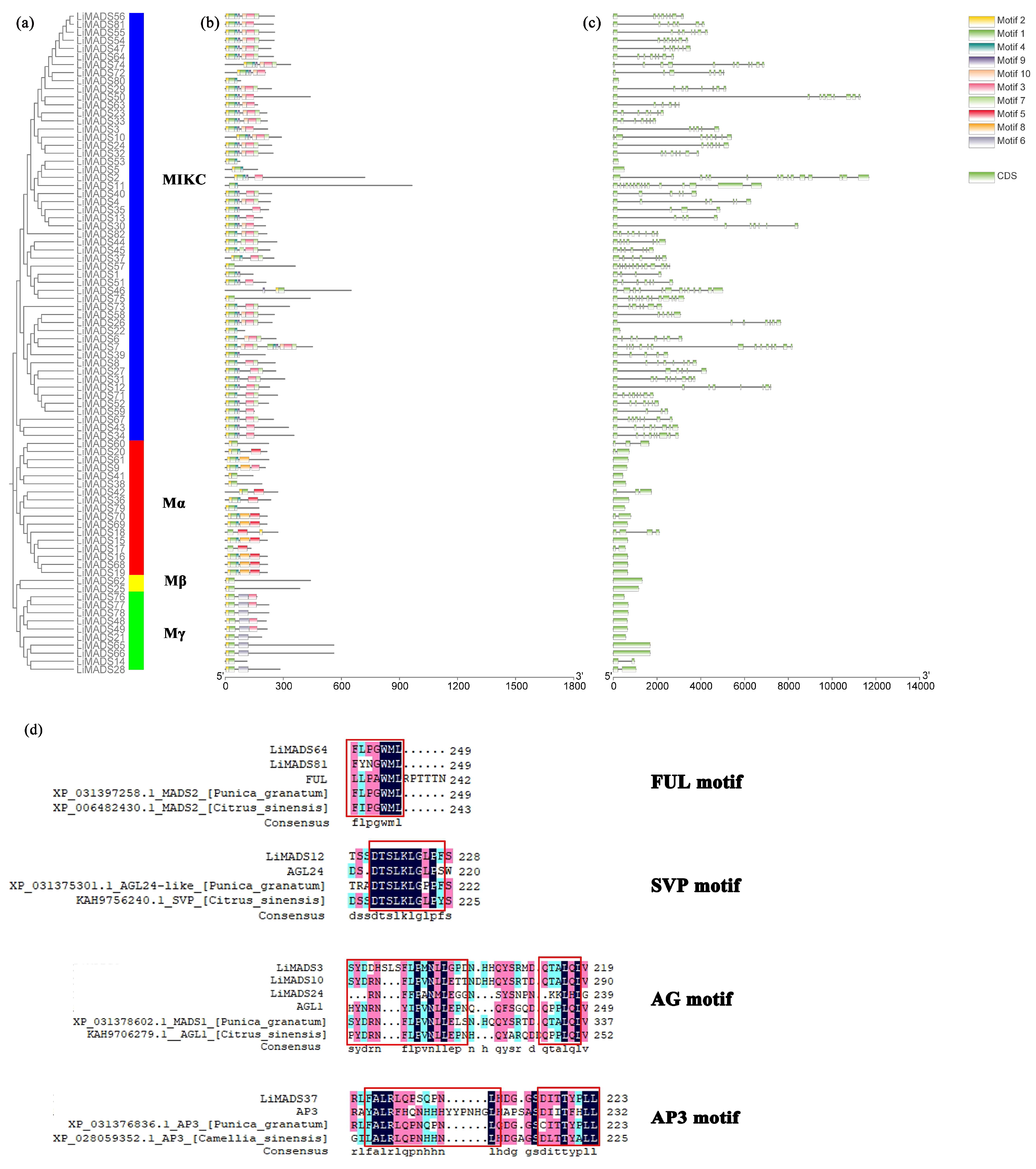
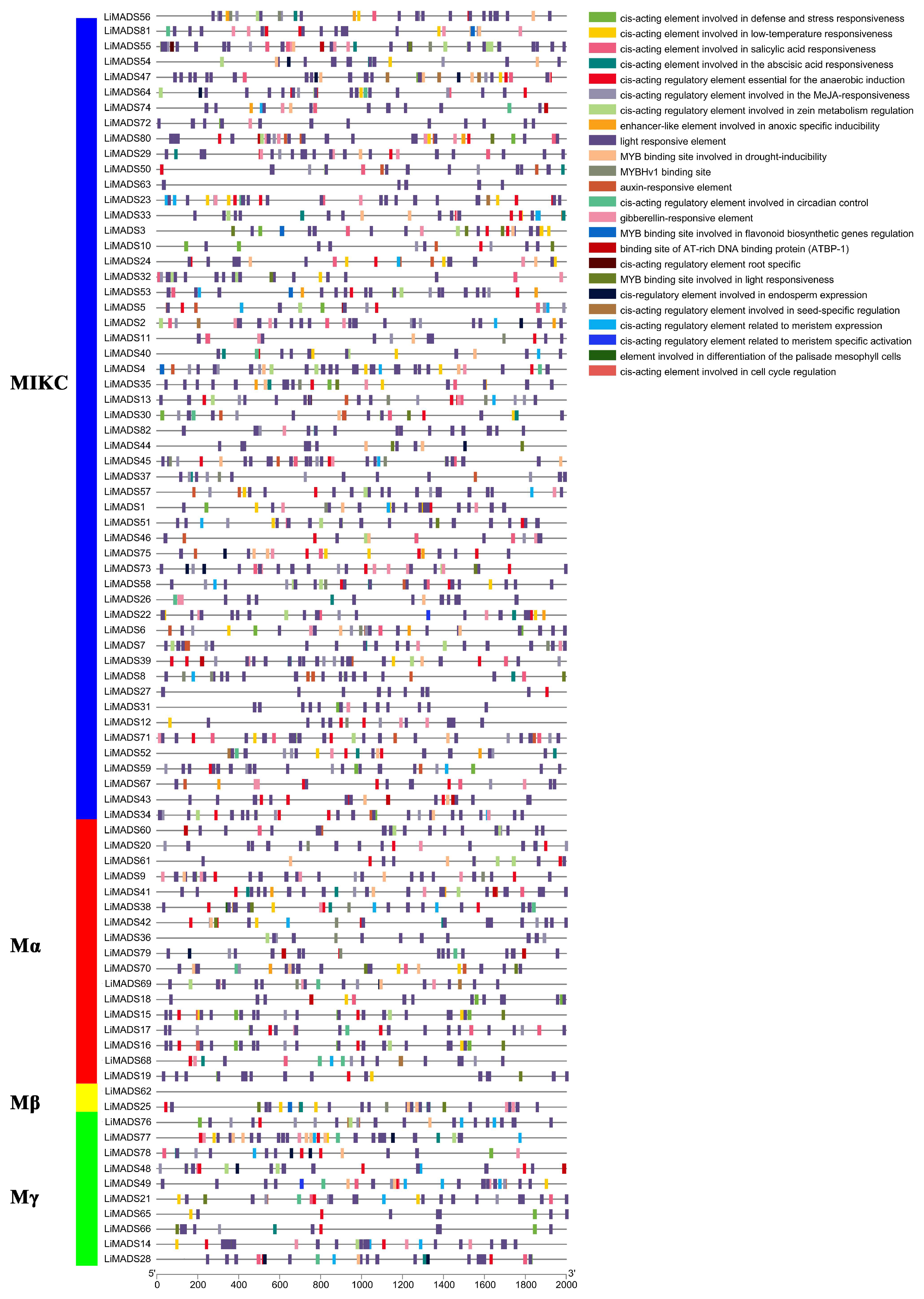
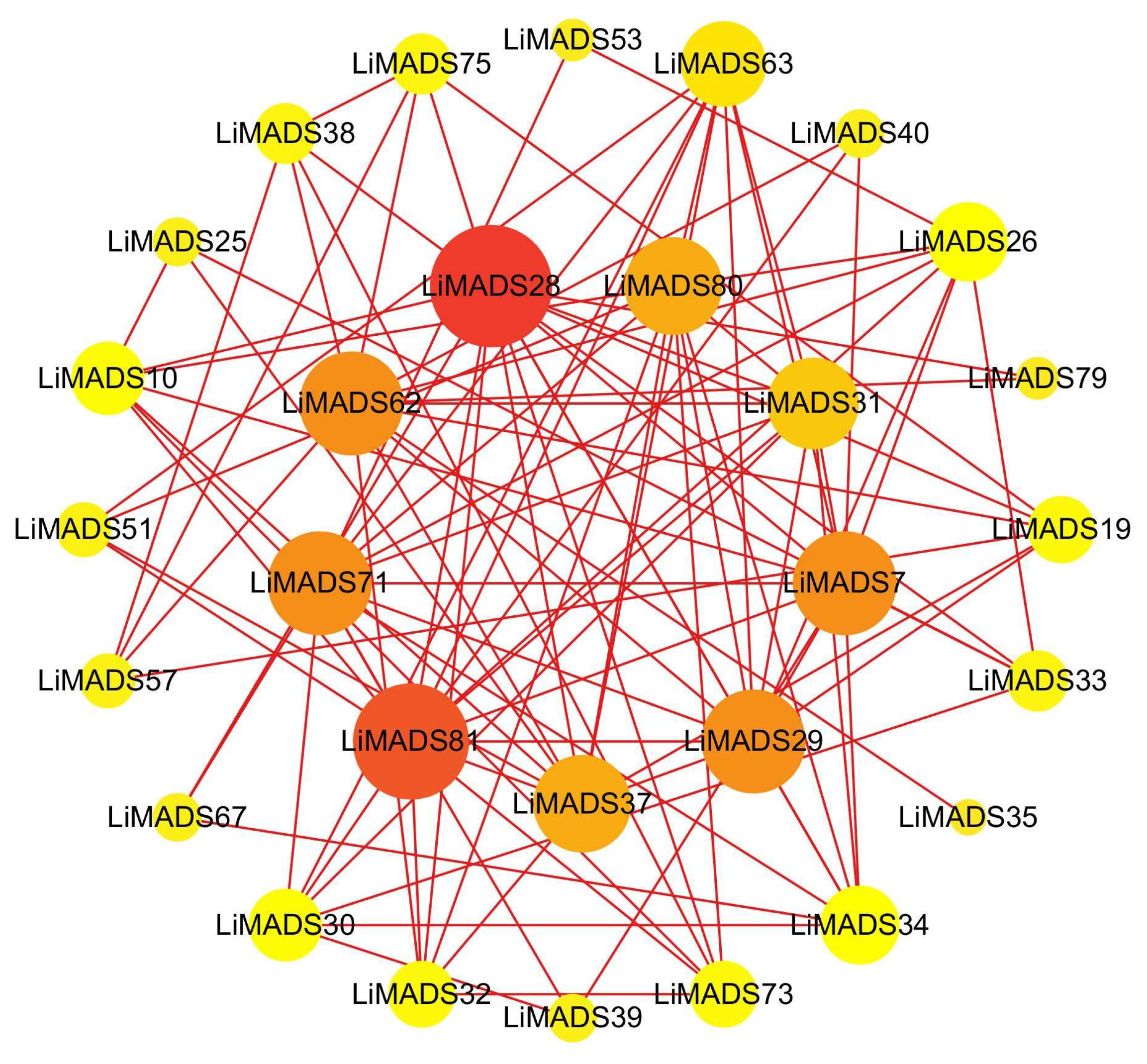



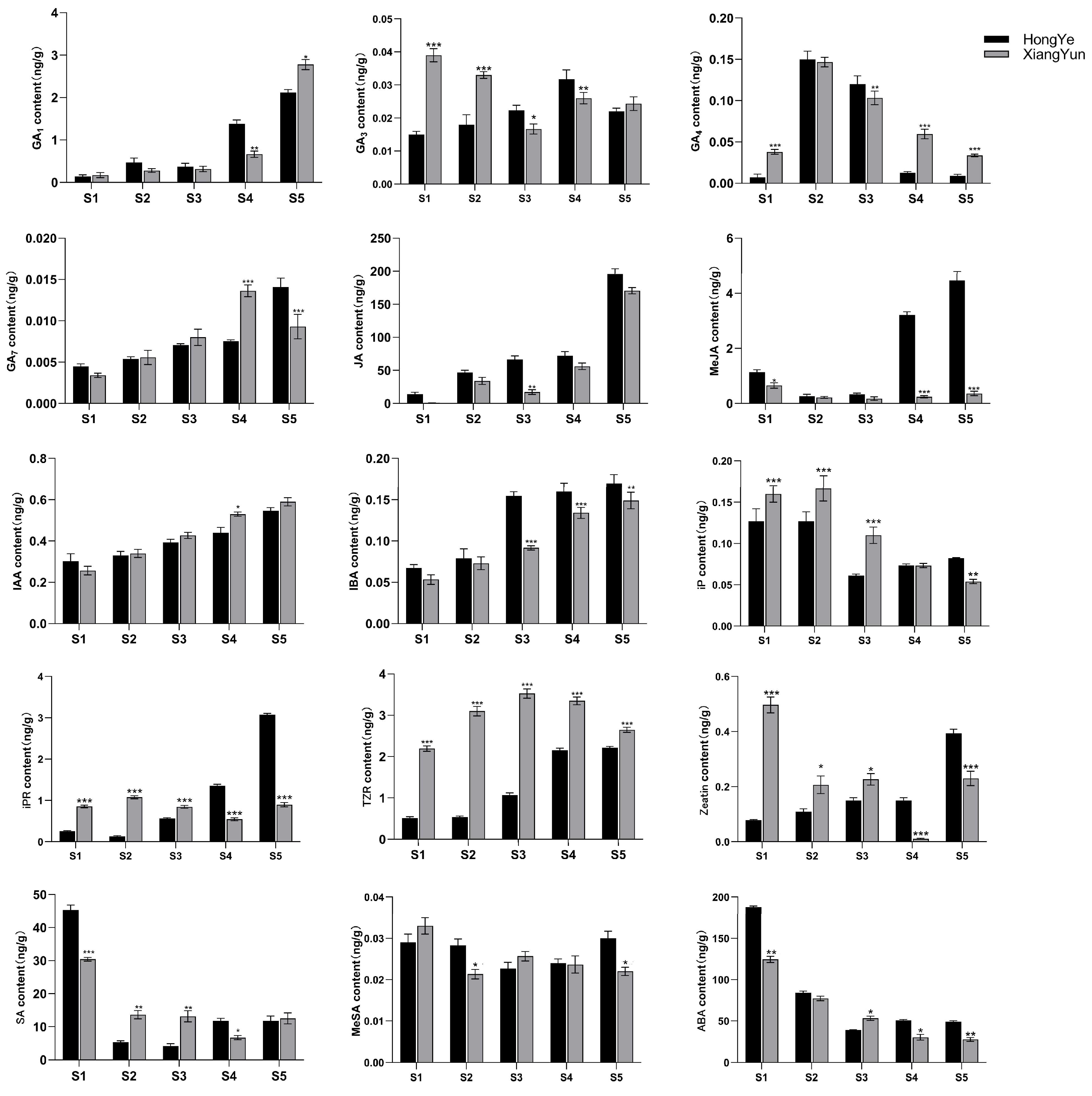
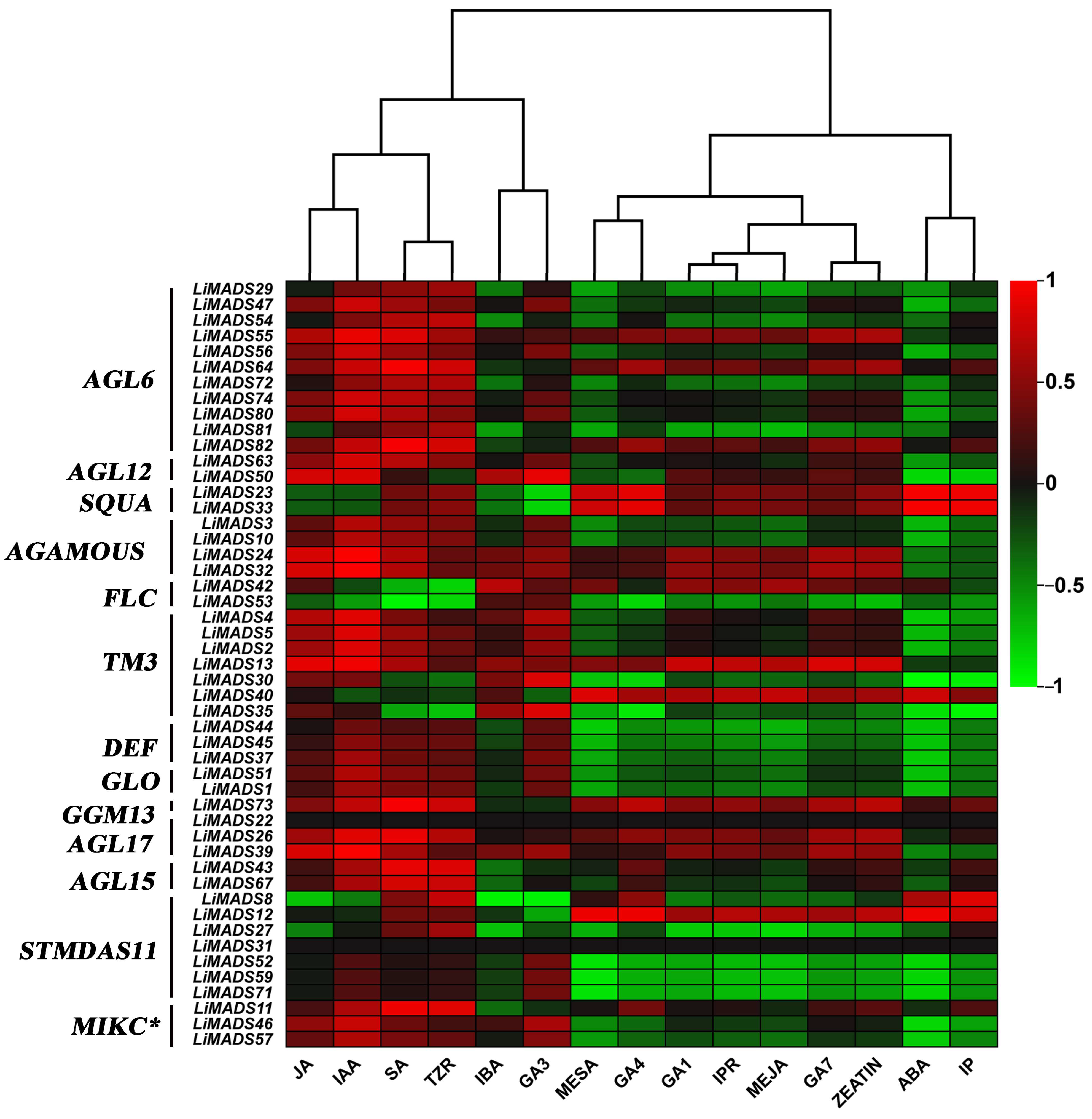
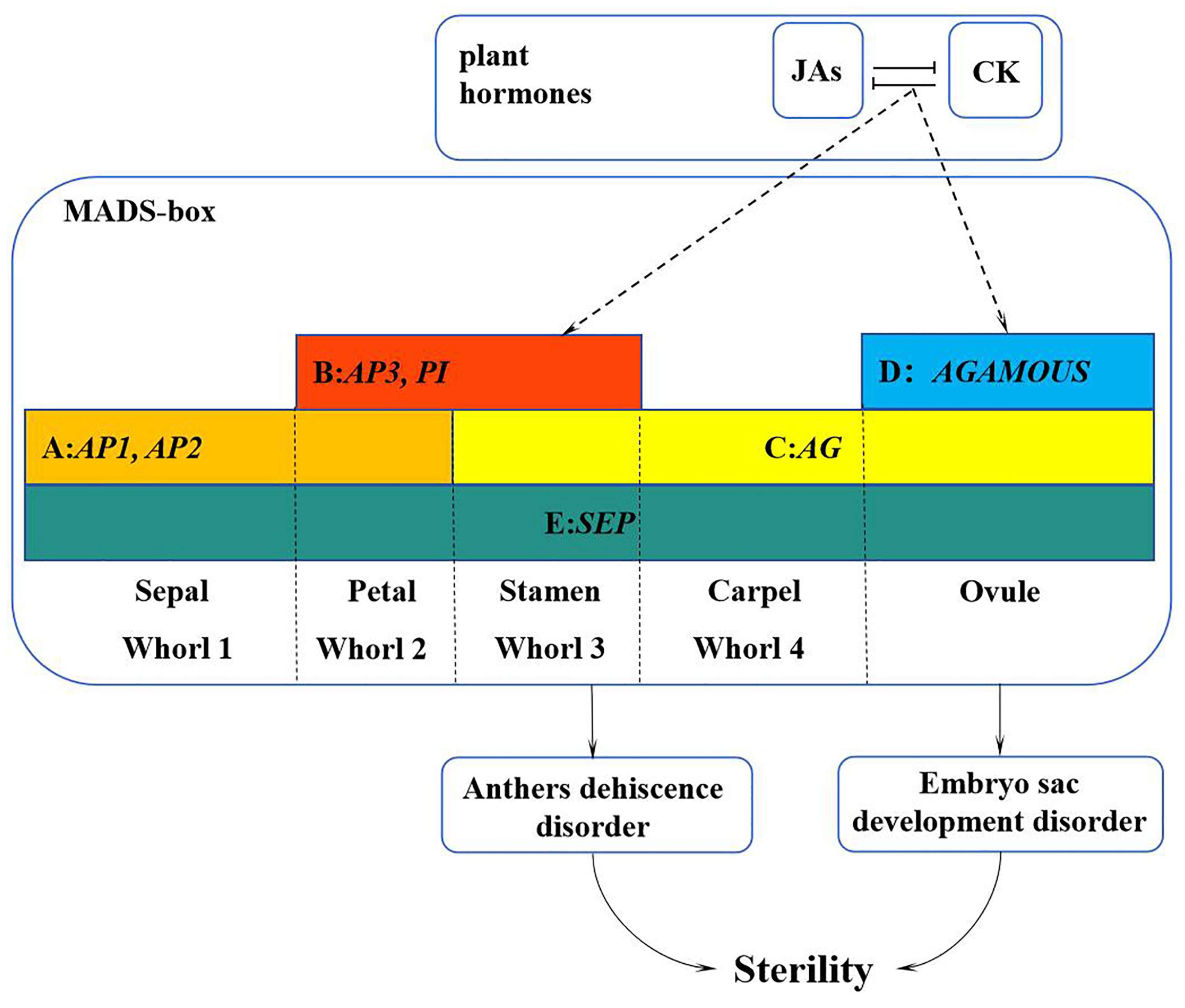
| Sequence ID | Chromosome | Number of Amino Acid | Molecular Weight | Theoretical PI | Subfamily | Type | Subcellular Localization |
|---|---|---|---|---|---|---|---|
| LiMADS1 | Chr1 | 143 | 16,347.72 | 9.30 | MIKC | Type II | Nucleus |
| LiMADS2 | Chr2 | 720 | 81,541.55 | 6.57 | MIKC | Type II | Nucleus |
| LiMADS3 | Chr2 | 219 | 25,363.98 | 9.42 | MIKC | Type II | Nucleus |
| LiMADS4 | Chr2 | 233 | 26,849.61 | 9.49 | MIKC | Type II | Nucleus |
| LiMADS5 | Chr3 | 166 | 18,608.16 | 9.77 | MIKC | Type I | Nucleus |
| LiMADS6 | Chr3 | 262 | 29,458.14 | 9.45 | MIKC | Type II | Nucleus |
| LiMADS7 | Chr3 | 450 | 51,212.25 | 7.11 | MIKC | Type II | Nucleus |
| LiMADS8 | Chr3 | 257 | 28,811.55 | 9.66 | MIKC | Type II | Nucleus |
| LiMADS9 | Chr3 | 207 | 22,949.55 | 9.40 | Mα | Type I | Nucleus |
| LiMADS10 | Chr3 | 290 | 33,123.44 | 9.11 | MIKC | Type II | Nucleus |
| LiMADS11 | Chr3 | 964 | 107,927.12 | 8.65 | MIKC | Type I | Nucleus |
| LiMADS12 | Chr4 | 229 | 25,466.16 | 9.56 | MIKC | Type II | Nucleus |
| LiMADS13 | Chr4 | 192 | 21,483.46 | 9.36 | MIKC | Type II | Nucleus |
| LiMADS14 | Chr5 | 112 | 12,247.65 | 5.27 | Mγ | Type I | Nucleus |
| LiMADS15 | Chr5 | 217 | 24,350.51 | 5.81 | Mα | Type I | Nucleus |
| LiMADS16 | Chr5 | 217 | 24,292.47 | 5.81 | Mα | Type I | Nucleus |
| LiMADS17 | Chr5 | 133 | 15,343.77 | 8.63 | Mα | Type I | Nucleus |
| LiMADS18 | Chr5 | 272 | 30,940.98 | 8.05 | Mα | Type I | Nucleus |
| LiMADS19 | Chr5 | 217 | 24,442.62 | 6.02 | Mα | Type I | Nucleus |
| LiMADS20 | Chr5 | 215 | 24,176.95 | 8.46 | Mα | Type I | Nucleus |
| LiMADS21 | Chr5 | 188 | 21,283.61 | 4.54 | Mγ | Type I | Nucleus |
| LiMADS22 | Chr5 | 100 | 11,055.98 | 9.57 | MIKC | Type I | Nucleus |
| LiMADS23 | Chr6 | 214 | 23,904.68 | 8.95 | MIKC | Type II | Nucleus |
| LiMADS24 | Chr6 | 239 | 27,585.52 | 9.30 | MIKC | Type II | Nucleus |
| LiMADS25 | Chr6 | 385 | 42,403.25 | 7.69 | Mβ | Type I | Nucleus |
| LiMADS26 | Chr6 | 242 | 27,877.93 | 9.44 | MIKC | Type I | Nucleus |
| LiMADS27 | Chr6 | 261 | 29,225.49 | 5.82 | MIKC | Type II | Nucleus |
| LiMADS28 | Chr6 | 282 | 31,904.09 | 9.51 | Mγ | Type II | Nucleus |
| LiMADS29 | Chr6 | 238 | 27,131.80 | 9.04 | MIKC | Type II | Nucleus |
| LiMADS30 | Chr6 | 208 | 23,761.39 | 8.49 | MIKC | Type II | Nucleus |
| LiMADS31 | Chr7 | 307 | 34,400.55 | 6.36 | MIKC | Type II | Nucleus |
| LiMADS32 | Chr7 | 247 | 28,520.48 | 8.77 | MIKC | Type II | Nucleus |
| LiMADS33 | Chr7 | 217 | 23,984.56 | 7.74 | MIKC | Type II | Nucleus |
| LiMADS34 | Chr8 | 354 | 40,377.15 | 7.63 | MIKC | Type II | Nucleus |
| LiMADS35 | Chr8 | 224 | 25,635.33 | 8.89 | MIKC | Type II | Nucleus |
| LiMADS36 | Chr8 | 235 | 25,934.06 | 5.89 | Mα | Type I | Nucleus |
| LiMADS37 | Chr8 | 251 | 28,951.37 | 6.04 | MIKC | Type II | Nucleus |
| LiMADS38 | Chr8 | 189 | 21,173.81 | 5.73 | Mα | Type I | Nucleus |
| LiMADS39 | Chr9 | 206 | 22,516.08 | 9.13 | MIKC | Type I | Nucleus |
| LiMADS40 | Chr9 | 239 | 27,232.87 | 9.49 | MIKC | Type II | Nucleus |
| LiMADS41 | Chr11 | 143 | 15,956.17 | 10.31 | Mα | Type I | Nucleus |
| LiMADS42 | Chr11 | 271 | 29,674.12 | 5.30 | MIKC | Type I | Nucleus |
| LiMADS43 | Chr11 | 326 | 35,876.75 | 6.05 | MIKC | Type II | Nucleus |
| LiMADS44 | Chr12 | 266 | 30,702.20 | 8.73 | MIKC | Type II | Nucleus |
| LiMADS45 | Chr12 | 230 | 26,301.00 | 8.86 | MIKC | Type II | Nucleus |
| LiMADS46 | Chr12 | 650 | 73,648.67 | 6.78 | MIKC | Type I | Nucleus |
| LiMADS47 | Chr12 | 236 | 27,188.86 | 6.46 | MIKC | Type II | Nucleus |
| LiMADS48 | Chr12 | 212 | 23,842.25 | 5.88 | Mγ | Type I | Nucleus |
| LiMADS49 | Chr12 | 216 | 24,415.90 | 5.90 | Mγ | Type I | Nucleus |
| LiMADS50 | Chr13 | 1784 | 199,613.24 | 9.01 | MIKC | Type II | Nucleus |
| LiMADS51 | Chr13 | 210 | 24,598.99 | 9.03 | MIKC | Type II | Nucleus |
| LiMADS52 | Chr14 | 223 | 25,281.74 | 5.95 | MIKC | Type II | Nucleus |
| LiMADS53 | Chr14 | 75 | 8748.21 | 9.93 | MIKC | Type I | Nucleus |
| LiMADS54 | Chr14 | 252 | 28,587.54 | 8.24 | MIKC | Type II | Nucleus |
| LiMADS55 | Chr15 | 255 | 28,989.91 | 7.59 | MIKC | Type II | Nucleus |
| LiMADS56 | Chr16 | 254 | 29,244.13 | 8.29 | MIKC | Type II | Nucleus |
| LiMADS57 | Chr16 | 361 | 40,440.63 | 5.18 | MIKC | Type I | Nucleus |
| LiMADS58 | Chr16 | 253 | 29,160.32 | 8.95 | MIKC | Type II | Nucleus |
| LiMADS59 | Chr16 | 150 | 17,238.80 | 9.14 | MIKC | Type II | Nucleus |
| LiMADS60 | Chr17 | 224 | 25,120.97 | 8.67 | Mα | Type I | Nucleus |
| LiMADS61 | Chr17 | 225 | 24,916.43 | 7.67 | Mα | Type I | Nucleus |
| LiMADS62 | Chr17 | 440 | 49,045.53 | 7.14 | Mβ | Type I | Nucleus |
| LiMADS63 | Chr17 | 166 | 19,540.50 | 9.86 | MIKC | Type II | Nucleus |
| LiMADS64 | Chr17 | 249 | 28,410.38 | 8.88 | MIKC | Type II | Nucleus |
| LiMADS65 | Chr17 | 560 | 61,472.15 | 6.55 | Mγ | Type I | Nucleus |
| LiMADS66 | Chr17 | 560 | 61,673.41 | 7.11 | Mγ | Type I | Nucleus |
| LiMADS67 | Chr17 | 249 | 27,930.73 | 6.56 | MIKC | Type II | Nucleus |
| LiMADS68 | Chr18 | 218 | 24,644.92 | 5.92 | Mα | Type I | Nucleus |
| LiMADS69 | Chr18 | 215 | 24,199.27 | 6.01 | Mα | Type I | Nucleus |
| LiMADS70 | Chr18 | 216 | 24,547.74 | 6.78 | Mα | Type I | Nucleus |
| LiMADS71 | Chr18 | 269 | 30,168.43 | 7.70 | MIKC | Type II | Nucleus |
| LiMADS72 | Chr19 | 208 | 23,887.52 | 9.40 | MIKC | Type II | Nucleus |
| LiMADS73 | Chr19 | 331 | 38,325.46 | 8.77 | MIKC | Type II | Nucleus |
| LiMADS74 | Chr20 | 337 | 37,643.01 | 8.73 | MIKC | Type II | Nucleus |
| LiMADS75 | Chr22 | 439 | 49,794.41 | 7.32 | MIKC | Type I | Nucleus |
| LiMADS76 | Chr22 | 164 | 18,941.46 | 9.66 | Mγ | Type I | Nucleus |
| LiMADS77 | Chr22 | 225 | 25,846.28 | 8.82 | Mγ | Type I | Nucleus |
| LiMADS78 | Chr22 | 225 | 25,501.79 | 6.45 | Mγ | Type I | Nucleus |
| LiMADS79 | Chr22 | 173 | 19,408.45 | 10.04 | Mα | Type I | Nucleus |
| LiMADS80 | Chr23 | 79 | 8773.17 | 9.84 | MIKC | Type I | Nucleus |
| LiMADS81 | Chr24 | 249 | 28,425.17 | 7.68 | MIKC | Type II | Nucleus |
| LiMADS82 | Chr24 | 214 | 24,851.74 | 9.77 | MIKC | Type II | Nucleus |
Disclaimer/Publisher’s Note: The statements, opinions and data contained in all publications are solely those of the individual author(s) and contributor(s) and not of MDPI and/or the editor(s). MDPI and/or the editor(s) disclaim responsibility for any injury to people or property resulting from any ideas, methods, instructions or products referred to in the content. |
© 2024 by the authors. Licensee MDPI, Basel, Switzerland. This article is an open access article distributed under the terms and conditions of the Creative Commons Attribution (CC BY) license (https://creativecommons.org/licenses/by/4.0/).
Share and Cite
Qiao, Z.; Deng, F.; Zeng, H.; Li, X.; Lu, L.; Lei, Y.; Li, L.; Chen, Y.; Chen, J. MADS-Box Family Genes in Lagerstroemia indica and Their Involvement in Flower Development. Plants 2024, 13, 709. https://doi.org/10.3390/plants13050709
Qiao Z, Deng F, Zeng H, Li X, Lu L, Lei Y, Li L, Chen Y, Chen J. MADS-Box Family Genes in Lagerstroemia indica and Their Involvement in Flower Development. Plants. 2024; 13(5):709. https://doi.org/10.3390/plants13050709
Chicago/Turabian StyleQiao, Zhongquan, Fuyuan Deng, Huijie Zeng, Xuelu Li, Liushu Lu, Yuxing Lei, Lu Li, Yi Chen, and Jianjun Chen. 2024. "MADS-Box Family Genes in Lagerstroemia indica and Their Involvement in Flower Development" Plants 13, no. 5: 709. https://doi.org/10.3390/plants13050709
APA StyleQiao, Z., Deng, F., Zeng, H., Li, X., Lu, L., Lei, Y., Li, L., Chen, Y., & Chen, J. (2024). MADS-Box Family Genes in Lagerstroemia indica and Their Involvement in Flower Development. Plants, 13(5), 709. https://doi.org/10.3390/plants13050709







